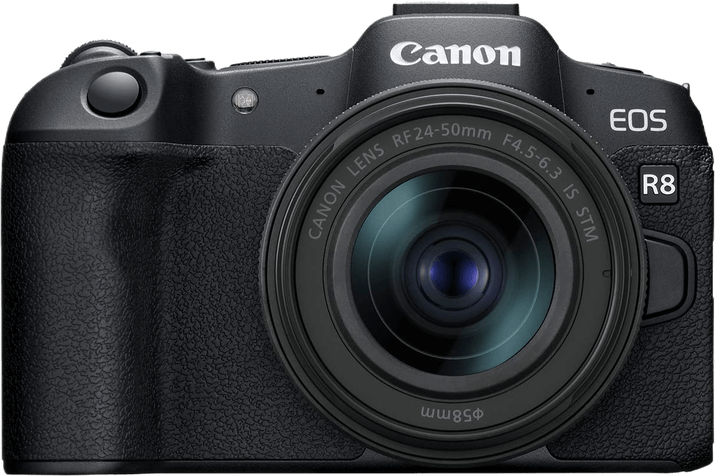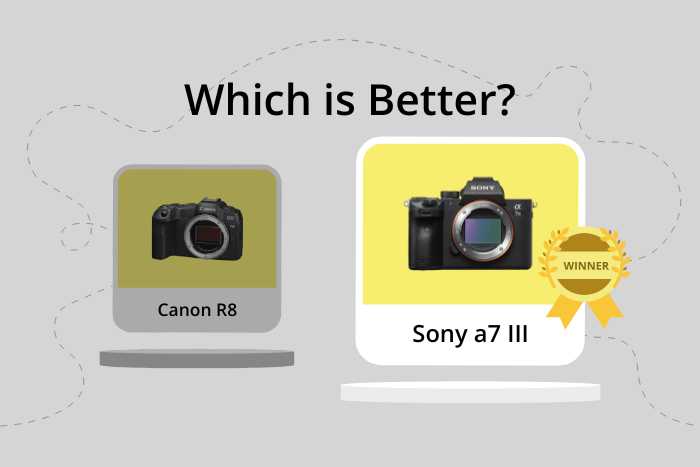Canon EOS R8 vs Sony a7 III Comparison
Canon EOS R8

Sony a7 III

The Sony a7 III outperforms the Canon EOS R8 with a score of 81 compared to 76/100. Both cameras are mirrorless and were released in different years, with the Sony a7 III launching in 2018 and the Canon EOS R8 in 2023. They share similarities in size, but the Canon EOS R8 is lighter at 461g, whereas the Sony a7 III weighs 650g.
The Canon EOS R8 is a more affordable option with a launch price of $1499, making it attractive for budget-conscious photographers. However, the Sony a7 III’s higher score shows that it delivers better performance and features despite its higher launch price of $2000.
While the Sony a7 III is the winner in terms of performance, the Canon EOS R8 has its advantages in weight and affordability. Ultimately, choosing between these cameras depends on individual preferences and priorities.
Canon EOS R8 vs Sony a7 III Overview and Optics
The Sony a7 III outperforms the Canon EOS R8 in optics with a score of 81/100 compared to the Canon’s 77/100. Both cameras have 24 and 24.2 megapixels, respectively, and share similar specifications such as CMOS sensors, full-frame sensor sizes, and lens mounts – Canon RF for the EOS R8 and Sony FE for the a7 III.
The Sony a7 III excels with its Bionz X processor and a DXOMARK sensor score of 96, which contributes to its higher optics score. This camera also offers image stabilization, a feature that the Canon EOS R8 lacks. These advantages make the Sony a7 III a more suitable choice for photographers seeking superior image quality and stability.
On the other hand, the Canon EOS R8 boasts a faster shooting speed of 40 compared to the Sony a7 III’s 10. Its Digic X processor, while not as highly rated as the Bionz X, still delivers reliable performance. Even with a lower DXOMARK sensor score of 94, the Canon EOS R8’s faster shooting speed may be more appealing to photographers who prioritize capturing fast-moving subjects.
To sum up, the Sony a7 III takes the lead in optics with its higher score, superior processor, and image stabilization feature. However, the Canon EOS R8 holds its ground with a faster shooting speed, making it a viable option for those who prioritize capturing action shots. Ultimately, the choice between these two cameras will depend on the individual photographer’s needs and preferences.
Canon EOS R8 vs Sony a7 III Video Performance
The Canon EOS R8 outperforms the Sony a7 III in video capabilities with a score of 91/100 compared to the Sony’s 70. Both cameras share some common specifications, such as a maximum video resolution of 4K and maximum video dimensions of 3840 x 2160. However, the differences in their video capabilities are evident in their scores.
The Canon EOS R8’s superiority is apparent in its higher maximum video frame rate of 180fps, compared to the Sony a7 III’s 30fps. This means that the Canon EOS R8 can capture smoother and more detailed slow-motion footage than the Sony a7 III.
The Canon EOS R8’s higher video score is a result of its superior video capabilities, such as the higher maximum video frame rate and built-in time-lapse functionality. These features make it a better choice for those who prioritize video performance.
Canon EOS R8 vs Sony a7 III Features and Benefits
The Canon EOS R8 wins the features comparison with a score of 85/100, while the Sony a7 III scores 81/100. Both cameras share several similarities, including a 3-inch screen size, touchscreen capabilities, flip screen, lack of GPS, and the presence of WIFI and Bluetooth.
The Canon EOS R8 outperforms the Sony a7 III in screen resolution, boasting 1,620,000 dots compared to the Sony’s 921,600 dots. This difference provides a clearer and sharper display for users, enhancing the overall user experience.
On the other hand, the Sony a7 III excels in some aspects. However, the given specifications do not show any clear advantage over the Canon EOS R8. Both cameras have their strengths and cater to different preferences and needs.
Taking into account the higher feature score and better screen resolution, the Canon EOS R8 emerges as the better choice for those who prioritize display quality. The Sony a7 III, while slightly behind in score, still offers a well-rounded set of features and remains a viable option for photographers. Ultimately, the decision between the two cameras depends on individual preferences and requirements.
Canon EOS R8 vs Sony a7 III Storage and Battery
The Sony a7 III outperforms the Canon EOS R8 in storage and battery with a score of 81 to 35. Both cameras accept SD, SDHC, and SDXC memory cards. The Sony a7 III boasts two memory card slots, while the Canon EOS R8 has only one. Additionally, the Sony a7 III supports Memory Stick Duo, Pro Duo, and Pro-HG Duo cards.
The Sony a7 III has a longer battery life, providing 750 shots compared to the Canon EOS R8’s 370 shots. The Sony a7 III uses an NP-FZ100 battery, while the Canon EOS R8 utilizes an LP-E17 battery.
Canon EOS R8 vs Sony a7 III Alternatives
Are you considering buying or upgrading from a Canon R8 or Sony a7 III? Our camera comparison tool can help you weigh up its price and performance against the competition.
Here are some related popular camera comparisons to check for inspiration:

